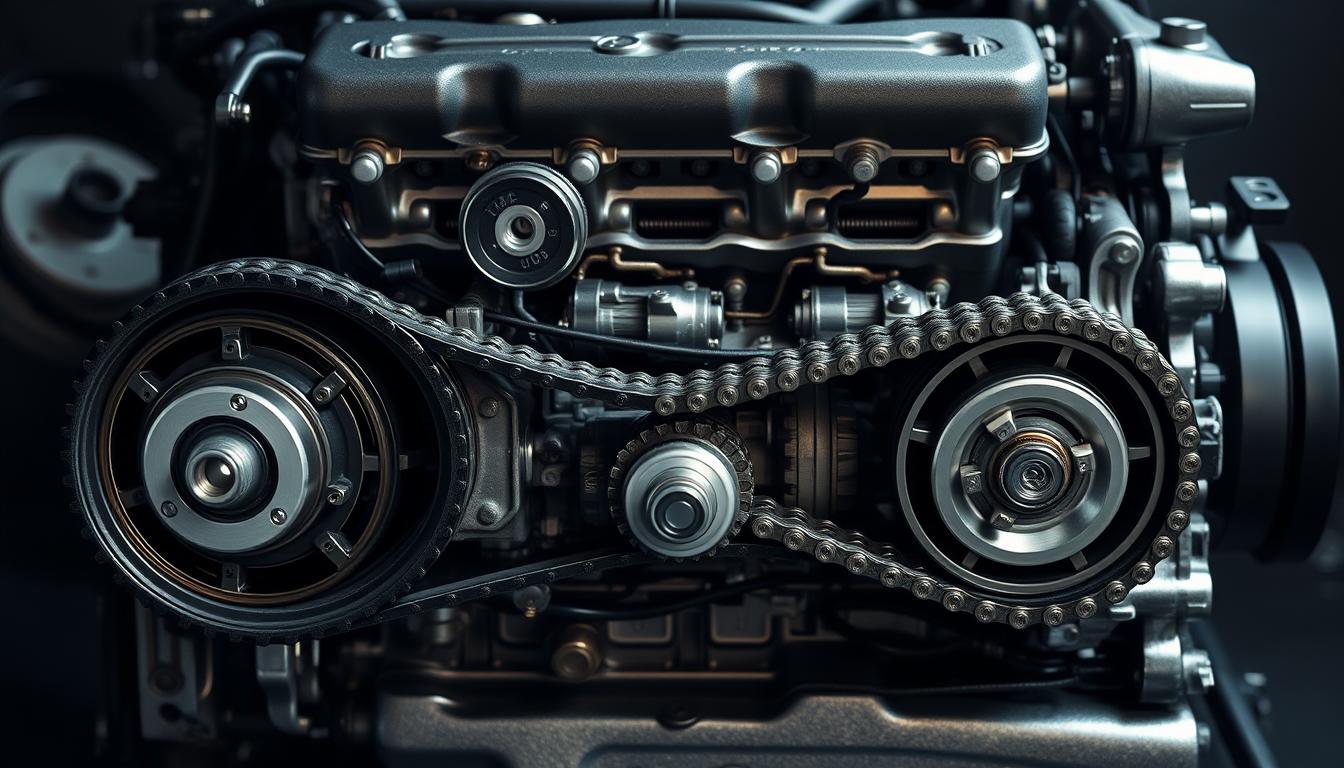Understanding your car’s engine is key to saving money on repairs. At the heart of every engine is either a timing belt or chain. Both are crucial for your car’s smooth operation.
These parts make sure your crankshaft and camshafts work together perfectly. This ensures valves open and close at the right time. Without this, your engine won’t run right or might not run at all.
For Toyota owners, knowing if your car has a belt or chain is important. Different Toyotas from the RAV4 to the Camry have different systems. You can check this list of Toyotas to see what’s in your car.
Why does this matter? The upkeep, lifespan, and risks of failure are different for belts and chains. We’ll dive into these differences to help you take better care of your Toyota’s engine.
Understanding Engine Timing Components
Knowing about the timing parts in your Toyota is key to keeping your engine running well. These parts make sure everything moves together smoothly. This lets your engine work efficiently.
Whether your Toyota has a timing belt or chain, these parts are vital. Each type has its own traits that affect how often you need to service it and how it drives.
The Role of Timing Systems in Toyota Engines
Timing systems in Toyota engines do one main thing: they match the crankshaft and camshaft’s rotation. This makes sure valves open and close at the right time with the pistons.
If timing is off, pistons could hit valves, causing catastrophic engine damage. The timing system makes sure the four-stroke cycle works right in your Toyota.
Toyota’s engineers pick between belts and chains for different models. Belts are quieter and found in cars where noise is a concern. Chains are more durable and last longer, but might be noisier.
How Timing Components Affect Engine Performance
The timing system affects many important things about your Toyota’s performance. It impacts:
- Power output and torque delivery
- Fuel efficiency and consumption rates
- Emission levels and environmental impact
- Engine noise and vibration characteristics
Modern Toyotas with variable valve timing need good timing parts to work well. These systems adjust valve timing for better performance in different driving situations.
Timing belts are smoother and quieter but need to be replaced more often. Timing chains last longer and are more durable, but might be noisier.
The choice between belt and chain affects performance and maintenance. Knowing which your Toyota has helps you plan for service and avoid engine issues.
What Is a Timing Belt?
In many Toyota engines, a timing belt is key. It’s a rubber part that links the crankshaft to the camshaft. This ensures the engine’s valves and pistons work together perfectly. Without it, your engine might not run right or at all.
Timing belts replaced chains in the 1970s and 1980s for quieter, more efficient engines. Toyota used them in many cars for these benefits. But, they’ve started using chains again in newer models.
The timing belt is hidden inside a cover, making it hard to see. Knowing about your Toyota’s timing system is very important.
Composition and Design of Toyota Timing Belts
Toyota timing belts are made of strong rubber and materials like Kevlar. This makes them last long and work well. They can handle the engine’s strong forces.
The belt has teeth that fit into grooves on the crankshaft and camshaft. This keeps everything in sync. Toyota makes these teeth very precise to avoid engine problems.
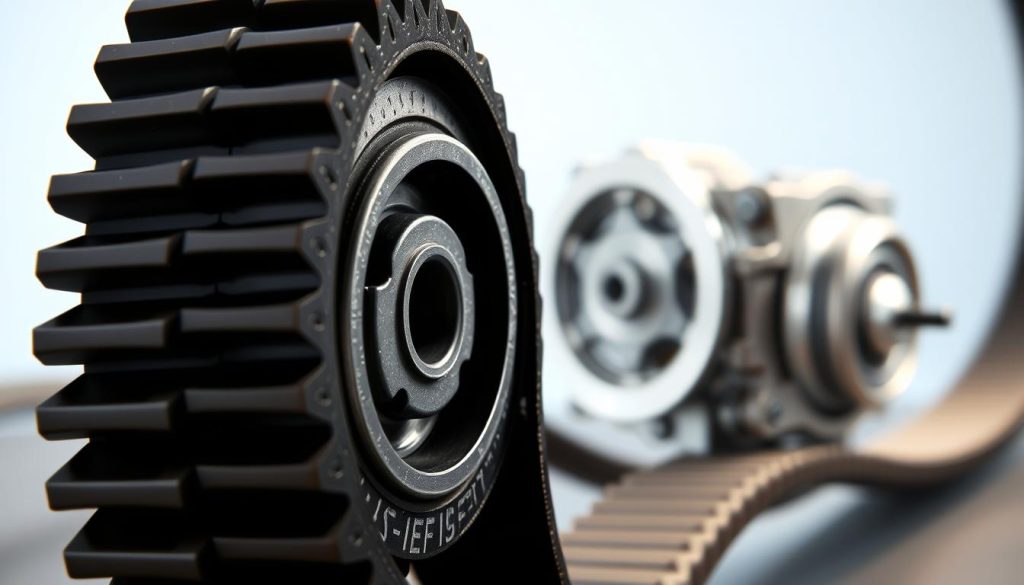
Over time, Toyota has made their timing belts better. They use new materials that last longer and work better in tough conditions. Now, you might not need to replace them until 90,000-100,000 miles.
Common Toyota Models with Timing Belts
Many Toyota models before 2010 have timing belts. Knowing which system your car has is key for keeping it running well. Here are some common models with timing belts:
Sedans and Passenger Cars:
- Camry: All engines (1990-2001), V6 models (1990-2006)
- Avalon: V6 models (1995-2004)
- Corolla: 4-cylinder models (1990-1997)
- Celica: 4-cylinder models (1990-1999)
- Solara: 4-cylinder (1999-2001), V6 (1999-2009)
SUVs and Crossovers:
- 4Runner: V6 (1990-2002), V8 (2003-2009)
- Highlander: V6 (2001-2007), Hybrid V6 (2006-2010)
- RAV4: 4-cylinder (1996-2000)
- Land Cruiser: V8 (1998-2007)
Trucks and Vans:
- Tacoma: V6 (1995-2004)
- Tundra: V6 (2000-2004), 4.7L V8 (2000-2009)
- Sienna: V6 (1998-2006)
- Sequoia: V8 (2001-2007, 2009)
Toyota has mostly switched to timing chains in newer models, after 2007-2010. But, check your VIN or owner’s manual to be sure.
What Is a Timing Chain?
At the heart of many Toyota engines is a timing chain system. It’s a metal alternative to rubber belts. This system coordinates critical engine functions.
Timing chains synchronize the rotation of the crankshaft and camshaft. They ensure valves open and close at the right moment. Unlike belts, these components are made of durable metal links, similar to bicycle chains but with higher precision and stress tolerance.
TheToyota timing chain benefitsinclude exceptional durability and minimal maintenance. Most Toyota owners with chain-driven engines enjoy a component designed to last a lifetime. While no part lasts forever, timing chains offer significant advantages for long-term ownership.
Construction and Materials of Toyota Timing Chains
Toyota timing chains are made of high-strength steel alloys. They are designed to withstand extreme tension and heat cycles. Each link connects through hardened pins for flexibility and strength through countless engine revolutions.
The metal composition extends theToyota timing chain lifespansignificantly. Often, they last 200,000 miles or more under proper conditions.
The chain design fits perfectly with toothed sprockets on both the crankshaft and camshaft. This creates a positive-drive system that eliminates slippage. Toyota engineers their timing chains with specific tensioning systems for optimal performance throughout their life.
Supporting components are crucial in the timing chain assembly. Guide rails direct the chain’s path and prevent harmful vibration. Hydraulic or spring-loaded tensioners apply the correct pressure to prevent slack. Oil jets lubricate the system during operation, further extending theToyota timing chain lifespan.
Toyota Models Typically Equipped with Timing Chains
Toyota has increasingly favored timing chains in their lineup, especially after 2007. This reflects Toyota’s commitment to reducing maintenance while improving reliability. Here’s a breakdown of Toyota models typically equipped with timing chains:
Toyota sedans and passenger cars with timing chains include:
– Camry (4-cylinder models from 2002-2012, V6 models from 2007-2012)
– Corolla (all 4-cylinder models from 1998-2012)
– Avalon (V6 models from 2005-2012)
– Camry Hybrid (all models from 2007-2012)
– Yaris (all models from 2007-2012)
– Prius (all models from 2001-2012)
Toyota SUVs and crossovers featuring timing chains include:
– RAV4 (4-cylinder models from 2001-2012, V6 models from 2006-2012)
– Highlander (4-cylinder models from 2001-2012, V6 models from 2008-2012)
– 4Runner (4-cylinder models from 1990-2000 and 2010, V6 models from 2003-2012)
– FJ Cruiser (all models from 2007-2012)
– Venza (all models from 2009-2012)
Toyota trucks and commercial vehicles with timing chains include:
– Tacoma (4-cylinder models from 1995-2012, V6 models from 2005-2012)
– Tundra (V6 models from 2005-2012, 4.6L and 5.7L V8 models from 2007-2012)
– Sienna (4-cylinder models from 2011-2012, V6 models from 2007-2012)
This shift toward chain-driven systems shows Toyota’s engineering evolution. TheToyota timing chain benefitsof reduced service requirements and enhanced durability align with the brand’s reputation for building vehicles that last long with minimal upkeep.
How to Identify Which Timing System Your Toyota Has
Finding out if your Toyota has a timing belt or chain is easy. Knowing this is important for maintenance or just to understand your car better. Here are three ways to figure out which timing system your Toyota uses.
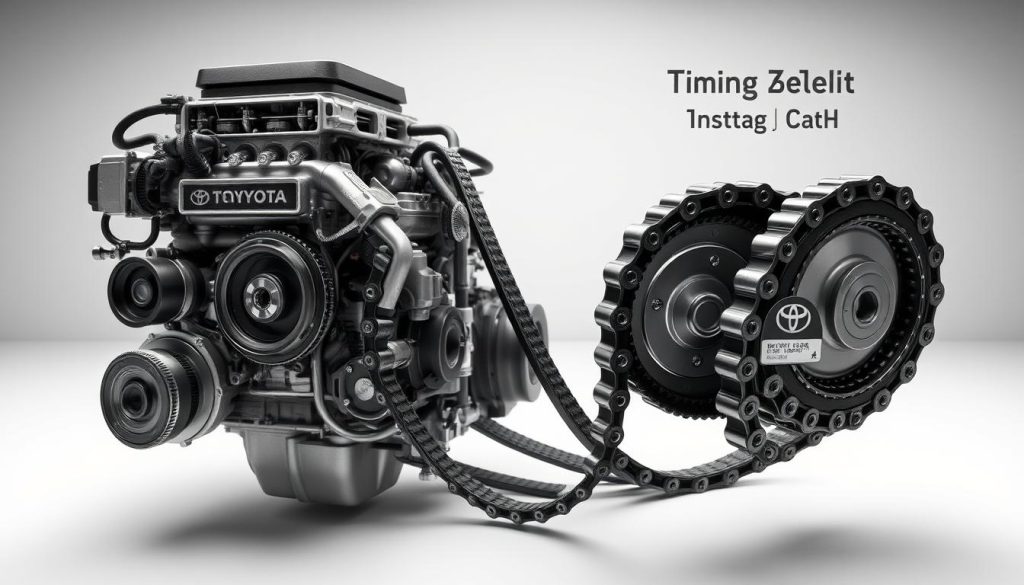
Using Your Vehicle Identification Number (VIN)
Your Toyota’s VIN holds key details, like the engine type. This 17-digit code is like a fingerprint for your car. It can tell you if your Toyota has a timing belt or chain.
The VIN’s 4th to 8th digits show the model, engine, and body style. To decode it:
- Find your VIN on the driver’s side dashboard or door jamb
- Use Toyota’s online VIN decoder or third-party services
- Ask your local Toyota dealership’s parts department
Parts staff can quickly check your engine specs with your VIN. This is especially helpful for used Toyota owners without full service records or when buying a used car.
Consulting Your Owner’s Manual
Your Toyota’s owner’s manual has all the details on the timing system. Look in the maintenance schedule or engine specs sections. These usually mention when to replace the timing belt if your car has one.
If it says to replace the timing belt (usually between 60,000-100,000 miles), your Toyota has a belt. If there’s no mention of timing belt maintenance, it likely has a timing chain.
Lost your manual? Toyota has digital copies on their official owner’s manual website. You can also find reliable PDFs on Toyota forums.
Visual Inspection Techniques
Inspecting your Toyota’s timing system hands-on is another way. Timing belts are visible on the engine’s front, behind a plastic cover. Timing chains are hidden inside the engine block.
To inspect visually:
- Find the engine’s front (usually the side by the radiator)
- Look for plastic covers on the engine’s side
- If needed, safely remove covers after the engine cools
Timing belts are rubber with visible teeth. Chains are metal, hidden inside the engine. This DIY method is great for those who like to see it for themselves.
Toyota Timing Belt vs Chain: Key Differences
The debate between Toyota timing belts and chains focuses on their construction, performance, and how they work. These differences affect maintenance, driving experience, and long-term costs. Knowing these differences helps Toyota owners make better choices and plan for future service needs.
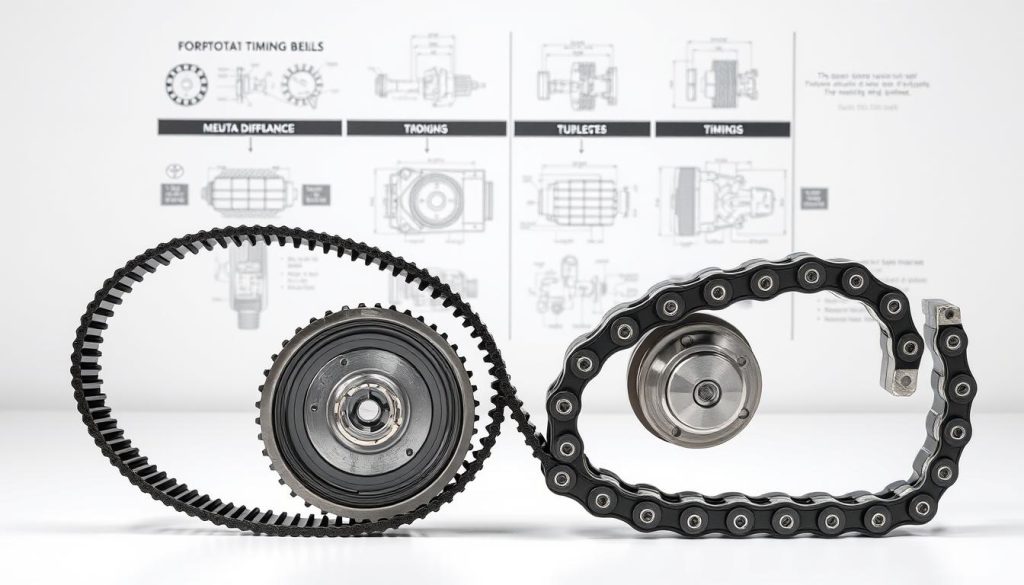
Structural and Material Differences
Timing belts in Toyota vehicles are made from rubber with added strength from materials like fiberglass or Kevlar. This makes them lightweight and flexible, with low friction.
Toyota timing chains, on the other hand, are made of metal links and rollers, similar to bicycle chains but stronger. They are heavier but more durable, handling high temperatures and stresses well.
The way these components are installed and maintained differs. Timing belts need precise tension, while chains use automatic or semi-automatic tensioners. The choice between rubber and metal affects how they perform in Toyota engines.
Performance and Efficiency Variations
Timing belts are lighter, which can improve fuel efficiency in some Toyotas. They help engines respond faster and may offer better acceleration.
Toyota timing chains, being heavier, offer consistent timing control over time. Metal chains stretch less than rubber belts, keeping valve timing precise even after years.
Engine design depends on the timing system chosen. Toyota uses belts for efficiency and chains for longevity and longer maintenance intervals. This explains why some Toyotas have one system over the other.
Noise and Vibration Characteristics
Timing belts are almost silent due to their rubber construction. This makes Toyota passenger vehicles feel refined. The quiet operation is key in luxury models.
Toyota timing chains make a slight mechanical sound. Modern designs have reduced this noise, but it’s still more noticeable than belts. However, a worn chain will rattle, signaling potential problems.
Unlike chains, timing belts can fail silently without warning sounds or vibrations. Regular checks and replacements are crucial for Toyota models with belts.
Advantages and Disadvantages of Timing Belts
The rubber-based timing belt system in many Toyota models has both good and bad points. Knowing these can help you plan your car’s upkeep and budget for possible replacements.
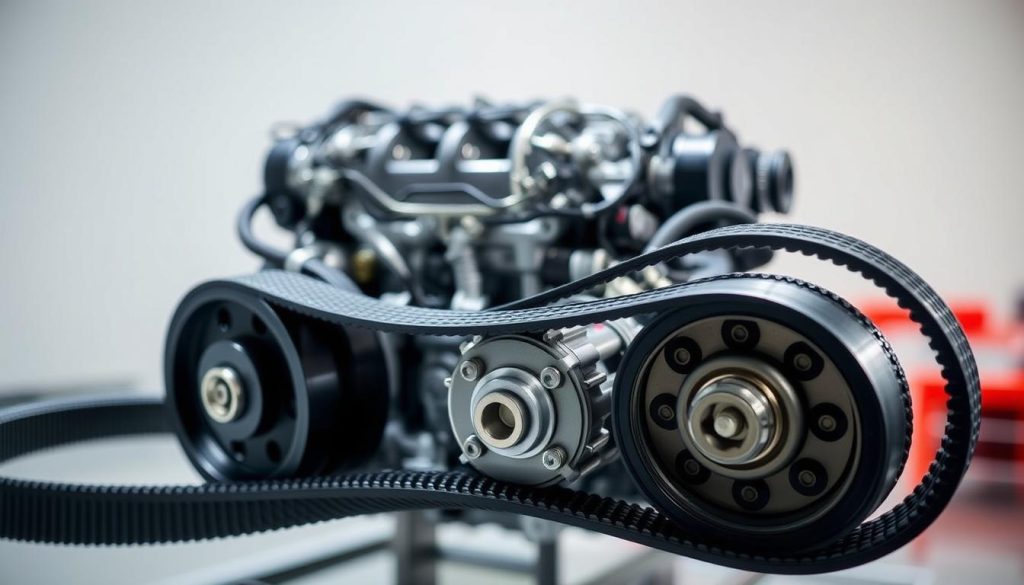
Benefits of Toyota Timing Belts
One big plus of Toyota timing belts is their quieter operation. The rubber absorbs vibrations, making less noise than metal chains. This makes driving in cars like the Camry and Avalon more comfortable.
Timing belts also help with improved fuel efficiency. They are lighter, so the engine uses less energy. This can save a bit of fuel over time and makes the car feel quicker.
Another advantage is they don’t need oil lubrication. This means you don’t have to worry about oil quality affecting the timing system. For many, this makes maintenance simpler.
When it’s time to replace the timing belt, it’s a chance to check other parts too. Mechanics often suggest replacing water pumps and other components at the same time. This can prevent future problems and save on labor costs.
Drawbacks of Belt-Driven Systems
The biggest drawback of timing belts is their limited lifespan. Unlike chains, they need to be replaced every 60,000 to 100,000 miles. This is a cost you can’t avoid.
Timing belts can fail without warning. Unlike chains, which often make noise before breaking, belts can snap suddenly. It’s crucial to follow the recommended replacement schedule.
If a timing belt breaks in “interference” engines, it can cause serious damage. Pistons and valves can collide, leading to expensive repairs. In some cases, the repair might cost more than the car itself.
Environmental factors like extreme temperatures or dirty oil can also shorten a belt’s life. Owners in harsh climates may need to check their belts more often. This helps avoid sudden failures.
Advantages and Disadvantages of Timing Chains
Toyota timing chains have many benefits but also some drawbacks. Knowing both sides helps owners make smart choices and plan for maintenance. Let’s look at what makes timing chains good and what might be a problem.
Benefits of Toyota Timing Chains
Exceptional durability is a big plus for Toyota timing chains. They can last as long as the car, unlike rubber belts. Their metal construction makes them tough against engine harshness.
Timing chains keep engine timing accurate over time. Belts stretch and wear out, but chains barely do. This means better engine performance and efficiency for years.
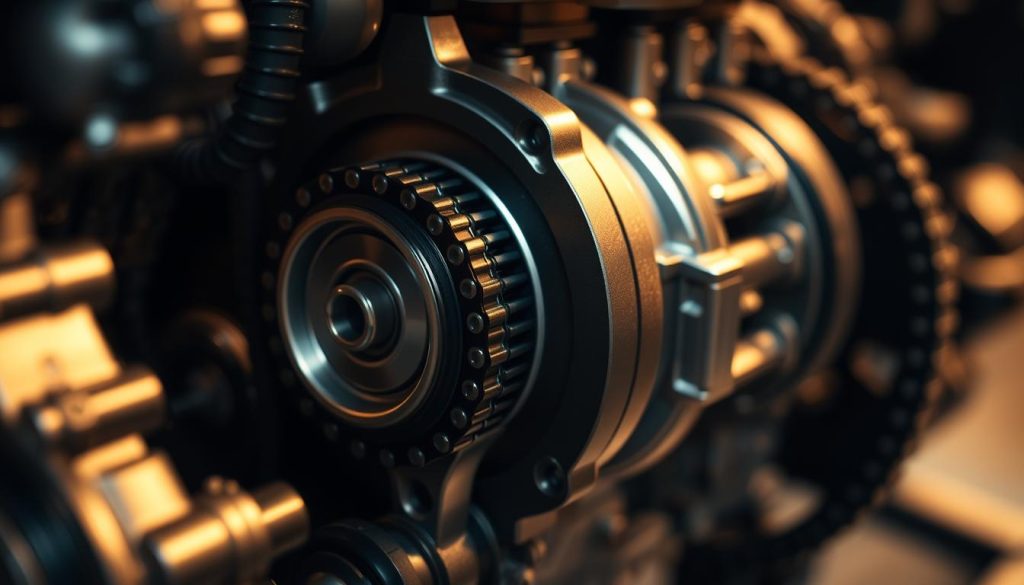
Timing chains also have a built-in warning system. When they start to wear, they make a rattling noise. This noise lets owners know to fix issues before engine damage happens.
Chains are also better at handling tough environments. Extreme temperatures, moisture, and oil don’t affect them as much as belts. This makes them great for areas with harsh weather.
From a cost point of view, chains save money on maintenance. They don’t need to be replaced as often as belts. This is good for owners who plan to keep their cars for a long time.
Drawbacks of Chain-Driven Systems
Despite their benefits, timing chains have some downsides. One big issue is they make more noise than belts. As they get older, this noise can make the car less quiet.
Chain systems are more complex than belt systems. They have more parts that can fail. If these parts break, it can cause serious engine damage.
While chains don’t need as much maintenance, repairs can be expensive. Replacing chain parts requires taking apart the engine, which costs more than belt repairs.
Chains rely on good engine oil for lubrication. Regular oil changes with the right oil are crucial. Without it, chains can wear out faster and fail early.
Some Toyota models with timing chains have had early wear issues. These problems were mainly in older models. But, newer models have fixed these issues, so it’s worth considering when buying an older car.
Lifespan Comparison: Belt vs Chain
Knowing how long your Toyota’s timing belt or chain lasts is key for good maintenance. This knowledge helps avoid expensive engine damage. Let’s look at how long each system lasts and what affects their durability.
Average Lifespan of Toyota Timing Belts
Toyota timing belts need to be replaced between 60,000 and 100,000 miles. This depends on the model and year. Newer Toyotas usually last longer than older ones.
Belts made of rubber can wear down fast, especially in hot weather. Cars driven in very hot places might need belt replacements more often.
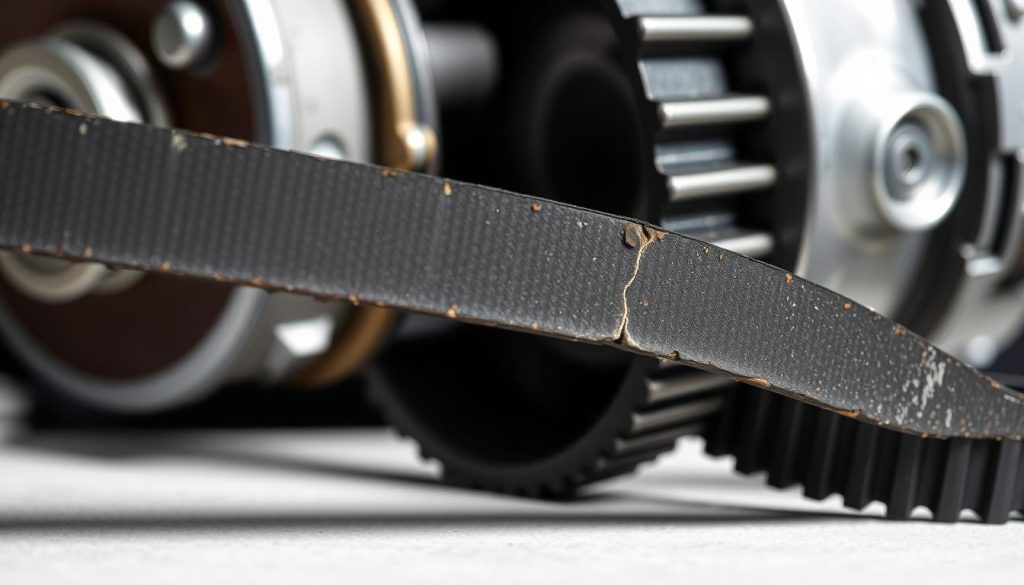
How you drive also affects belt life. Frequent stops and starts can wear it down faster. Dusty areas can also damage the belt’s teeth.
Toyota has made belts last longer over time. For example, the 1MZ-FE V6 engine in older Camrys needed belt replacement at 60,000 miles. But newer models can go up to 90,000 miles or more.
Expected Longevity of Toyota Timing Chains
Toyota timing chains are very durable, lasting 200,000 to 300,000 miles or more. This makes them a big plus over belts.
Chains are made of metal, which is stronger than rubber belts. But, they need oil to keep working well. Regular oil changes with the right oil are key to their long life.
Not all Toyota chains are the same. Some models, like the 2007-2011 Camry with the 2AZ-FE engine, had issues. But these are rare.
Today’s Toyota chains are made better, with new materials and designs. They usually last longer than other engine parts if you take care of them.
| Toyota Model | Engine | Timing System | Typical Replacement Interval | Maintenance Notes |
|---|---|---|---|---|
| Camry (2002-2006) | 2.4L 2AZ-FE | Chain | 200,000+ miles | Regular oil changes critical |
| Corolla (2009-2020) | 1.8L 2ZR-FE | Chain | Lifetime | Inspect at 120,000 miles |
| 4Runner (1996-2002) | 3.4L 5VZ-FE | Belt | 60,000-90,000 miles | Critical for interference engine |
| Tacoma (2005-2015) | 4.0L 1GR-FE | Belt | 90,000 miles | Replace water pump simultaneously |
| RAV4 (2013-present) | 2.5L 2AR-FE | Chain | 200,000+ miles | Listen for chain noise |
Maintenance Requirements for Toyota Timing Belts
Toyota timing belts need special care that changes with the model and how you drive. Unlike timing chains, belts wear out and need to be replaced to avoid engine damage. Knowing what your car needs is key to keeping it running well and avoiding expensive repairs later.
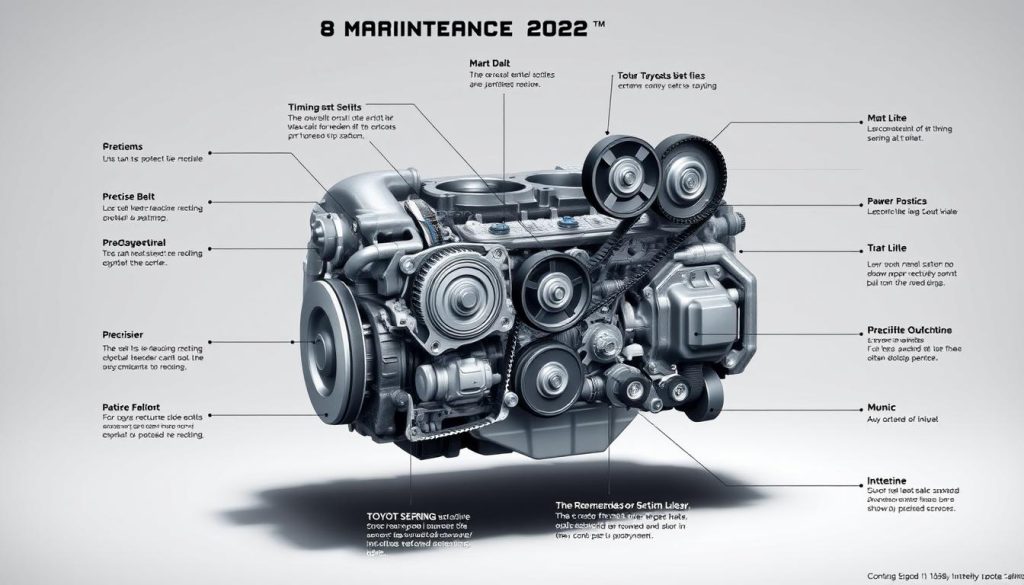
Recommended Inspection Intervals by Model
Toyota sets different maintenance times for timing belts in their cars. Most models need a new belt between 55,000 and 90,000 miles. But, the exact time can vary a lot.
For Camry V6 models made before 2007, Toyota says to replace the belt every 90,000 miles. The Avalon from before 2005 also needs this. But, older 4Runner V6 models (before 2003) and Tacoma V6 trucks (before 2005) might need it sooner, around 60,000 miles.
Toyota also considers “normal” and “severe” driving conditions. If you drive in very hot or cold weather, or in dusty places, or make lots of short trips, your car is in the severe category. This means you might need a new belt 15,000 to 30,000 miles before the usual time.
Even before the belt needs to be replaced, Toyota suggests checking it during regular service visits. These checks can spot problems early. Always keep records of when you replace the timing belt. This helps a lot when you sell your car.
Signs of Timing Belt Wear and Damage
Spotting signs of belt wear can stop engine damage. A good timing belt looks smooth and has clear teeth with no wear. Look for these signs during inspections:
- Cracks or splits on the belt’s surface or edges
- Fraying along the edges of the belt
- Glazing or a shiny appearance on the belt surface
- Missing teeth or visible rubber particles near the belt
Signs like rough idling, hard starting, or check engine codes related to timing can mean belt trouble. Unlike chains, belts usually don’t make noise before they fail, so checking them visually is crucial.
Oil or coolant leaks near the timing belt cover need quick action. These fluids can quickly damage the belt and cause it to fail early.
Preventative Maintenance Tips
To make your Toyota timing belt last longer, take a proactive approach to care. Here are some tips to help:
- Replace related parts like water pumps, tensioners, and idler pulleys when you service the belt
- Fix oil leaks right away to keep the belt clean
- Keep the engine cool to prevent overheating
- Use Toyota Genuine Parts or high-quality aftermarket parts for replacements
When you get your timing belt serviced, consider replacing other parts too. This can save money because you won’t have to take the engine apart again later. Replacing the water pump and tensioners at the same time can cut down on labor costs.
Changing the engine coolant regularly also helps your timing belt. Overheating can make the belt wear out faster. Keeping the cooling system in good shape helps keep the engine at the right temperature and makes the belt last longer.
Maintenance Needs for Toyota Timing Chains
Knowing how to care for your Toyota’s timing chain can save you a lot of money. It can also make your engine last longer. Timing chains are built to last, but they still need some care.
Toyota timing chains are made to last as long as your engine, if everything goes right. But, real-world driving can affect them. Regular checks are key to avoiding big problems and expensive fixes.
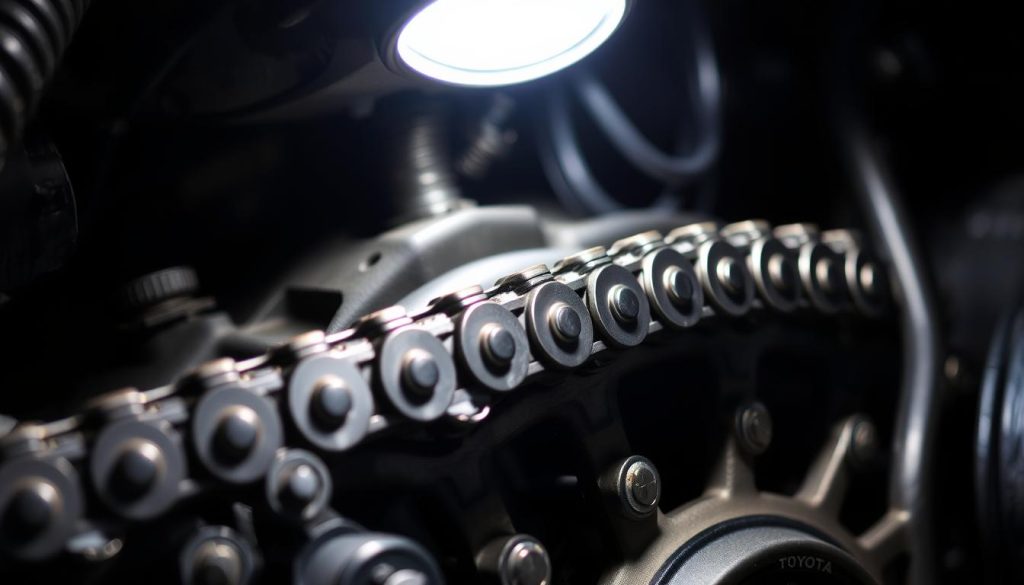
Inspection Guidelines for Timing Chains
Even though Toyota timing chains don’t need to be replaced as often as belts, they still need checks. Most car makers suggest checking them during regular maintenance, especially after driving a lot (60,000-90,000 miles).
Professional technicians check timing chains in a few ways:
- They listen for rattling sounds when the engine is cold.
- They look for metal in the oil that means the chain is wearing out.
- They use special tools to measure how much the chain has stretched.
- They check the chain’s tensioners and guides to make sure they’re working right.
Keeping your engine’s oil clean is like taking care of your timing chain. Using the right oil and changing it when you should helps prevent wear. Clean oil keeps the chain well-lubricated and in the right tension.
Newer Toyotas have special systems that can spot timing chain problems early. During service visits, techs can connect to your car’s computer to look for any issues.
Warning Signs of Timing Chain Issues
Unlike belts, Toyota timing chains usually show signs of trouble before they fail. Spotting these signs early can help fix problems before they get worse.
| Warning Sign | Description | Severity Level | Recommended Action |
|---|---|---|---|
| Rattling Noise | Metallic rattling sound, especially during cold starts | Moderate | Immediate inspection |
| Check Engine Light | Illuminated with camshaft position sensor codes | High | Diagnostic scan needed |
| Performance Issues | Rough idle, power loss, poor fuel economy | Moderate to High | Professional evaluation |
| Starting Difficulty | Engine hard to start or misfiring | High | Immediate service required |
| Oil Pressure Warning | Low oil pressure light (may indicate tensioner issues) | Critical | Stop driving and tow to service |
Most timing chain problems in Toyotas start slowly, giving you time to fix them. A worn chain can make your engine run poorly before it fails completely.
If you see any of these signs, especially in Toyotas like the RAV4, Corolla, or Avalon, get it checked right away. Fixing a timing chain is expensive, but it’s cheaper than fixing a damaged engine.
Cost Analysis: Toyota Timing Belt vs Chain
Looking at the cost of Toyota timing belts versus chains, we see three key areas: initial costs, labor, and long-term costs. Many Toyota owners only look at the upfront cost without seeing the whole picture. Knowing these differences helps you plan your maintenance budget and choose the right vehicle.
Initial Installation and Replacement Costs
The cost to replace timing belts in Toyotas is much lower than chains. Belt replacements cost between $500 to $900, with the belt itself costing $150-$250. The rest goes to parts like tensioners and idlers, and often the water pump.
On the other hand, timing chain replacements are more expensive, costing $1,200 to $2,000. The chain itself is about $180, but the labor needed raises the total cost. Toyota Timing Chain benefits include lasting much longer, often the car’s entire life with proper care.
The quality of parts also affects the cost. Genuine Toyota parts are 30-50% more than aftermarket ones. While cheaper, aftermarket parts might not last as long, leading to more frequent replacements.
Labor Expenses by Model
Labor costs vary a lot depending on the Toyota model and engine design. Four-cylinder engines, like in the Corolla, need 2-3 hours for belt replacement. V6 engines in models like the Highlander or Avalon take 4-6 hours due to their complexity.
The 4Runner and Tacoma are more challenging, needing 5-7 hours of labor. This is because they require a lot of disassembly to access the timing components. Labor rates are $85-$150 per hour, depending on where you go and who does the work.
| Toyota Model | Timing Belt Labor Hours | Timing Chain Labor Hours | Average Total Cost (Belt) | Average Total Cost (Chain) |
|---|---|---|---|---|
| Corolla (4-cyl) | 2-3 hours | 5-7 hours | $550-$650 | $1,200-$1,500 |
| Camry (V6) | 4-5 hours | 6-8 hours | $700-$850 | $1,400-$1,800 |
| Highlander | 4-6 hours | 7-9 hours | $750-$900 | $1,500-$2,000 |
| 4Runner/Tacoma | 5-7 hours | 8-10 hours | $800-$950 | $1,600-$2,200 |
Long-term Financial Considerations
When thinking about the cost of owning a car over time, timing belts and chains have different profiles. A Toyota with a timing belt needs replacement every 60,000-90,000 miles. This means a car kept for 150,000 miles will need at least one, possibly two replacements. This adds up to $1,000-$1,800 over the car’s life.
On the other hand, Toyotas with timing chains have lower long-term costs. Although the initial cost is higher, the chain can last over 200,000 miles with proper care. This can save $500-$1,000 over 150,000 miles compared to belt-driven systems.
Resale value also plays a role. A Toyota with a recent Toyota timing belt replacement can sell for $300-$500 more. This is because buyers know they won’t have to worry about this expense soon. This can help offset the Toyota timing belt cost for sellers who keep their vehicles well-maintained before selling.
Step-by-Step Toyota Timing Belt Replacement Guide
For Toyota owners, this guide helps with timing belt maintenance. Replacing the timing belt is a complex DIY task. But with the right prep and focus, you can do it well. Remember, each Toyota model might have different steps, so always check your service manual.
Step 1: Preparation and Required Tools
Start by getting all the tools and parts you need. You’ll require basic tools like socket sets, wrenches, and screwdrivers. You’ll also need specialized equipment like a crankshaft holding tool and timing pin set for your Toyota.
It’s better to buy a complete timing belt kit. These kits include tensioners, idler pulleys, and often a new water pump. These parts should be replaced with the belt.
First, make sure your safety is a priority. Disconnect the battery and let the engine cool down. Clear space around the engine and secure your car. Having your Toyota’s service manual handy is key for correct torque and model-specific steps.
Step 2: Accessing and Removing the Old Belt
Start by removing parts that block the timing belt area. This includes drive belts, engine covers, and sometimes the radiator fan. On many Toyotas, you’ll need to support the engine and remove the right motor mount.
Rotate the crankshaft to top dead center (TDC). Look for alignment marks on the camshaft and crankshaft pulleys. Proper alignment is critical to avoid damage to valves and pistons.
After verifying alignment, loosen the tensioner. Release the belt’s pressure. Note the belt’s path before removing it. Different engines have unique paths and challenges. Remove the old belt carefully, ensuring camshafts stay aligned.
Step 3: Installing the New Timing Belt
Before putting in the new belt, check that all timing marks are aligned. Install new tensioners and idler pulleys, following your Toyota’s manual for torque.
Follow the old belt’s path for the new one, starting at the crankshaft. Each Toyota engine has its own path, so be careful with your documentation.
Apply the right tension as specified by Toyota. After installation, rotate the crankshaft by hand to check timing marks. This ensures everything is in sync.
Put back all removed parts in reverse order. Record the mileage and date of the replacement. Apply the timing belt replacement sticker under the hood. This careful process keeps your Toyota’s engine running smoothly for years.
Common Toyota Timing Belt Problems and Solutions
Knowing the signs of Toyota timing belt problems is key to keeping your car running well. Toyota cars are reliable, but their timing belts can still have issues. Learning about these problems and how to fix them can help you avoid expensive repairs.
Frequent Issues and Their Causes
Extreme temperatures can damage timing belts. Cold weather makes the rubber brittle, while hot weather makes it too soft. This can cause the belt to wear out faster.
Oil leaks and coolant spills can also harm timing belts. These fluids can break down the rubber, making the belt weak. This can cut the belt’s life in half or more.
Problems with other car parts can also damage the timing belt. If the tensioners, idler pulleys, or water pumps don’t work right, the belt can slip or wear unevenly.
Some Toyotas made between 2001-2003 have timing belt issues. These problems can show up as cracks or tooth separation on the belt’s inner side.
Putting the timing belt on wrong can cause problems. If it’s not set up right, it can squeal, wear out too fast, or slip.
| Problem | Cause | Solution | Prevention |
|---|---|---|---|
| Belt squealing | Too loose tension | Adjust to proper specifications | Follow Toyota service manual |
| Premature wear | Too tight tension | Replace belt and set correct tension | Use tension gauge tool |
| Misalignment | Improper pulley positioning | Realign components | Verify timing marks during installation |
| Belt slippage | Worn tensioner | Replace tensioner with belt | Always replace related components |
Consequences of Timing Belt Failure
How bad timing belt failure is depends on your Toyota’s engine type. Toyota engines are either interference or non-interference. Knowing this is important for understanding the damage.
Ininterference engines, pistons and valves are in the same space but at different times. If the timing belt breaks, these parts can collide. This can damage valves, pistons, and even crack cylinder heads. Many V6 engines in Toyotas, like the Camry and Highlander, are interference designs. Fixing this damage can cost between $2,000 and $4,000.
Non-interference engines, found in some older Corollas and Tercels, have more space between pistons and valves. While a broken belt still means you’re stuck, repairs are usually cheaper, around $500-$800.
Timing belt failures often happen during stressful driving, like on highways. This is because the belt is under more strain at high RPMs. This can leave you stranded far from help.
The timing belt maintenance schedule for Toyotas is usually between 60,000 to 100,000 miles. Sticking to this schedule can prevent the serious problems of a broken timing belt. Preventive replacement is always cheaper than fixing a broken belt.
Common Toyota Timing Chain Problems and Fixes
Knowing about Toyota timing chain problems can help avoid expensive engine damage. Timing chains are more durable than belts but can still face issues over time. Let’s look at common problems Toyota owners face and what happens when these parts fail.
Typical Chain Issues in Toyota Vehicles
The main issue with Toyota timing chains is stretching. As they get older, the metal links stretch, causing timing problems. This usually starts after 80,000-100,000 miles, depending on how you drive and maintenance.
Chain tensioners and guides often fail first, leading to more problems. When tensioners can’t keep the chain tight, it can slap against parts, making a rattling noise. This noise is your earliest warning sign of timing chain issues.
Oil quality is key to keeping timing chains running well. Toyota engines need clean, high-quality oil to lubricate the chain system. Using low-quality oil can shorten the chain’s life by 30-50%.
Some Toyota engines are more prone to timing chain problems. The 2AZ-FE 2.4L 4-cylinder engine (2002-2009) and early 2GR-FE 3.5L V6 engines have had issues. Aftermarket changes that increase engine RPM or power can also wear out the chain faster.
Impact of Timing Chain Failure
Timing chain failures in Toyota engines go through stages. You might first notice small performance issues like rough idling or decreased fuel economy. As it gets worse, engine misfires and power loss become more obvious.
When the chain breaks, it’s a big problem, especially in interference-type engines. Pistons and valves can collide, causing serious engine damage. Broken chain debris can also damage other engine parts.
| Timing Chain Issue | Warning Signs | Potential Damage | Typical Repair Cost |
|---|---|---|---|
| Chain Stretch | Rattling noise, check engine light | Gradual timing issues, reduced performance | $1,200-$1,800 |
| Tensioner Failure | Cold-start rattle, metallic noise | Chain damage, guide wear | $800-$1,500 |
| Guide Breakage | Intermittent rattling, metal fragments in oil | Chain damage, oil contamination | $1,000-$2,000 |
| Complete Chain Failure | Engine won’t start, severe internal noise | Catastrophic engine damage | $2,500-$4,000+ |
Fixing Toyota timing chain failures can cost between $2,500 and $3,500. This is because the engine needs to be partially taken apart to fix the chain. It’s one of the most complex engine repairs.
For older Toyotas with high mileage, replacing the engine might be cheaper than fixing the timing chain. This is especially true if valves, pistons, and cylinder heads get damaged. Catching problems early can save a lot of money and avoid unexpected breakdowns.
Toyota Model-Specific Timing System Insights
Understanding Toyota’s timing systems is key to keeping your car running smoothly. Knowing which models use belts or chains helps you plan for maintenance. This knowledge can save you money and prevent engine damage.
Let’s look at how different Toyota models handle their timing systems.
Passenger Cars: Camry, Corolla, and Avalon
The Camry, Toyota’s top sedan, used belts until 2002 for 4-cylinder engines. Then, it switched to chains. V6 models followed in 2007.
The Corolla changed earlier, using belts from 1990 to 1997. Then, it moved to chains in 1998. Most Corollas now have maintenance-free timing chains that last a long time.
Avalon models also changed, with V6 engines using belts until 2004. In 2005, they switched to chains. This shows Toyota’s move towards more durable timing systems.
| Model | Years | Engine | Timing System | Replacement Interval |
|---|---|---|---|---|
| Camry | 1990-2001 | All engines | Belt | 60,000-90,000 miles |
| Camry | 2002-2012 | 4-cylinder | Chain | Lifetime |
| Corolla | 1990-1997 | 4-cylinder | Belt | 60,000 miles |
| Corolla | 1998-2012 | 4-cylinder | Chain | Lifetime |
SUVs: RAV4, Highlander, and 4Runner
The RAV4, Toyota’s compact crossover, used belts until 2001. Then, it switched to chains. This means most RAV4s today have long-lasting timing chains.
The Highlander has a mixed history. 4-cylinder models always had chains, but V6 models used belts until 2007. Then, they switched to chains in 2008. This means Highlander owners need to check their engine type for maintenance needs.
The 4Runner has a complex timing system history. While 4-cylinder models used chains, V6 engines used belts until 2003. V8 models used belts until 2009. Owners of older 4Runners should check their timing belt interval, which is about 90,000 miles.
Trucks: Tacoma, Tundra, and Commercial Vehicles
The Tacoma’s 4-cylinder engines have always used chains since 1995. But, V6 engines used belts until 2005. Then, the 4.0L engine brought chain technology to all Tacoma engines.
The Tundra also changed, with early V6 models using belts until 2004. Then, they switched to chains in 2005. V8 options show an interesting progression: the 4.7L V8 used belts until 2009, while newer 4.6L and 5.7L V8 engines use chains exclusively.
Commercial Toyota vehicles like the discontinued T100 and specialized variants followed similar patterns. The Toyota timing chain benefits of reduced maintenance and longer service intervals are common. But, owners of older models should check their specific configuration.
| Truck Model | Years | Engine | Timing System | Notable Characteristics |
|---|---|---|---|---|
| Tacoma | 1995-2012 | 4-cylinder | Chain | Exceptional durability |
| Tacoma | 1995-2004 | V6 | Belt | 90K mile replacement |
| Tacoma | 2005-2012 | V6 | Chain | Lifetime service |
| Tundra | 2007-2012 | 5.7L V8 | Chain | Low maintenance design |
Conclusion
Knowing the difference between Toyota timing belts and chains is key for every Toyota owner. We’ve seen that neither is better than the other. Each has its own benefits, depending on how you drive and what you prefer for maintenance.
Toyota started using timing chains in most models after 2005-2007. This change is because of better chain technology. Chains last longer and need less maintenance, saving you money in the long run.
For cars with timing belts, it’s important to follow Toyota’s replacement schedule. You should replace the belt every 60,000-100,000 miles, depending on your car’s model. If you don’t, your engine could fail, costing a lot to fix.
When looking for a Toyota, remember that a well-kept car with a timing belt can be very reliable. The choice between a belt and a chain isn’t everything. What really matters is the car’s overall condition and maintenance history.
Your driving habits and plans for your car should decide what you choose. If you’re keeping your Toyota for a long time, a chain might be cheaper. But if you have a Toyota with a belt, just plan to replace it regularly.
Always check your owner’s manual or talk to a Toyota expert for advice on your car. With the right care, your Toyota will run well, whether it has a belt or a chain.
FAQ
How do I know if my Toyota has a timing belt or chain?
Check your owner’s manual or look up your Vehicle Identification Number (VIN) to see if your Toyota has a timing belt or chain. Most Toyotas made after 1998-2002 have timing chains. V6 engines before 2007 often have belts. The Camry and RAV4 switched to chains in 2007 and 2001, respectively.
How often should I replace my Toyota timing belt?
Toyota suggests replacing timing belts every 60,000 to 100,000 miles. For older V6 Camry models, it’s at 90,000 miles. Always follow your owner’s manual for the right time. Replacing it early is safer than risking engine damage.
Do Toyota timing chains need to be replaced?
Toyota timing chains are meant to last as long as the engine. They don’t need a scheduled replacement. With regular oil changes, they can last 200,000-300,000 miles. But, they still need occasional checks.
What happens if my Toyota timing belt breaks while driving?
If your Toyota has an “interference” engine, a broken timing belt can damage the engine. This can cost ,000-,000 to fix. Most V6 engines are interference designs. Non-interference engines might just stop and need a tow.
What are the warning signs of a failing Toyota timing belt?
Timing belts often fail without warning. Look for unusual noises, engine misfiring, or trouble starting. Visible cracks or oil leaks are also signs. The best indicator is mileage; replace it at the recommended time.
How can I tell if my Toyota timing chain is going bad?
Failing timing chains make noises, especially during cold starts. They also trigger the check engine light. Look for rough idling, poor performance, or metal shavings in the oil. These signs give you time to fix it before it fails.
How much does it cost to replace a Toyota timing belt?
Replacing a Toyota timing belt costs 0-0. This includes parts like water pumps and tensioners. Labor is a big part of the cost since it requires removing engine parts.
Is it worth replacing a timing chain on an older Toyota?
Replacing a timing chain on an older Toyota is worth it if the car is in good shape. It’s cheaper than engine replacement or buying a new car. A new chain can add 100,000+ miles to your car’s life.
Which Toyota engines are interference vs. non-interference?
Most Toyota engines are interference designs. This includes many V6 engines and some 4-cylinder models. Older 4-cylinder engines are non-interference. Always check your engine type.
Do Toyota hybrid models use timing belts or chains?
Toyota hybrids, like the Prius and Camry Hybrid, use timing chains. This is part of Toyota’s effort to reduce maintenance. The chains in hybrids are designed to last the car’s life with proper care.
What additional parts should be replaced when changing a Toyota timing belt?
Replace the water pump, tensioner, idler pulleys, and front engine seals when changing a timing belt. These parts have similar lifespans and are easy to replace during the belt service. Most kits include these parts for a complete maintenance job.
Can I drive my Toyota if the timing belt is making noise?
No, don’t drive your Toyota if the timing belt is noisy. Timing belts often fail without warning. The noise might be from other parts, indicating a bigger problem. Have your car checked right away to avoid engine damage.
What Toyota models switched from timing belts to chains?
Many Toyota models switched to chains:
– Camry: 4-cylinder in 2002, V6 in 2007
– RAV4: Switched in 2001
– Highlander: V6 in 2008
– 4Runner: V6 in 2003
– Tacoma: V6 in 2005 (with the 4.0L engine)
– Avalon: Switched in 2005
This change shows Toyota’s focus on easier-to-maintain engines.
Does Toyota recommend timing belt replacement earlier in severe driving conditions?
Yes, Toyota suggests replacing timing belts sooner if you drive in severe conditions. This includes short trips, extreme temperatures, and dusty areas. Check your manual for the right interval based on your driving.
What’s the Toyota timing belt replacement interval for the Tacoma V6?
For 1995-2004 Tacoma V6 models, replace the timing belt at 90,000 miles or 60,000 miles in severe conditions. 2005 and newer models have a 4.0L engine with a timing chain that doesn’t need replacement. Always check your model and engine type for the correct schedule.
